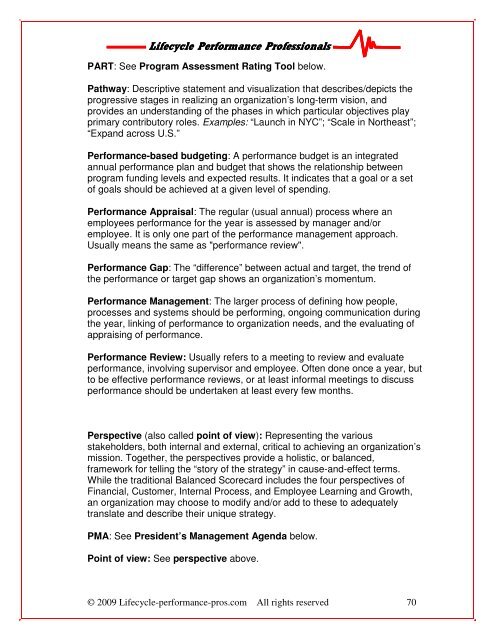Download the Performance Management Fundamentals Guide
Download the Performance Management Fundamentals Guide
Download the Performance Management Fundamentals Guide
Create successful ePaper yourself
Turn your PDF publications into a flip-book with our unique Google optimized e-Paper software.
Lifecycle Lifecycle <strong>Performance</strong> <strong>Performance</strong> Professionals<br />
Professionals<br />
PART: See Program Assessment Rating Tool below.<br />
Pathway: Descriptive statement and visualization that describes/depicts <strong>the</strong><br />
progressive stages in realizing an organization’s long-term vision, and<br />
provides an understanding of <strong>the</strong> phases in which particular objectives play<br />
primary contributory roles. Examples: “Launch in NYC”; “Scale in Nor<strong>the</strong>ast”;<br />
“Expand across U.S.”<br />
<strong>Performance</strong>-based budgeting: A performance budget is an integrated<br />
annual performance plan and budget that shows <strong>the</strong> relationship between<br />
program funding levels and expected results. It indicates that a goal or a set<br />
of goals should be achieved at a given level of spending.<br />
<strong>Performance</strong> Appraisal: The regular (usual annual) process where an<br />
employees performance for <strong>the</strong> year is assessed by manager and/or<br />
employee. It is only one part of <strong>the</strong> performance management approach.<br />
Usually means <strong>the</strong> same as "performance review".<br />
<strong>Performance</strong> Gap: The “difference” between actual and target, <strong>the</strong> trend of<br />
<strong>the</strong> performance or target gap shows an organization’s momentum.<br />
<strong>Performance</strong> <strong>Management</strong>: The larger process of defining how people,<br />
processes and systems should be performing, ongoing communication during<br />
<strong>the</strong> year, linking of performance to organization needs, and <strong>the</strong> evaluating of<br />
appraising of performance.<br />
<strong>Performance</strong> Review: Usually refers to a meeting to review and evaluate<br />
performance, involving supervisor and employee. Often done once a year, but<br />
to be effective performance reviews, or at least informal meetings to discuss<br />
performance should be undertaken at least every few months.<br />
Perspective (also called point of view): Representing <strong>the</strong> various<br />
stakeholders, both internal and external, critical to achieving an organization’s<br />
mission. Toge<strong>the</strong>r, <strong>the</strong> perspectives provide a holistic, or balanced,<br />
framework for telling <strong>the</strong> “story of <strong>the</strong> strategy” in cause-and-effect terms.<br />
While <strong>the</strong> traditional Balanced Scorecard includes <strong>the</strong> four perspectives of<br />
Financial, Customer, Internal Process, and Employee Learning and Growth,<br />
an organization may choose to modify and/or add to <strong>the</strong>se to adequately<br />
translate and describe <strong>the</strong>ir unique strategy.<br />
PMA: See President’s <strong>Management</strong> Agenda below.<br />
Point of view: See perspective above.<br />
© 2009 Lifecycle-performance-pros.com All rights reserved 70










